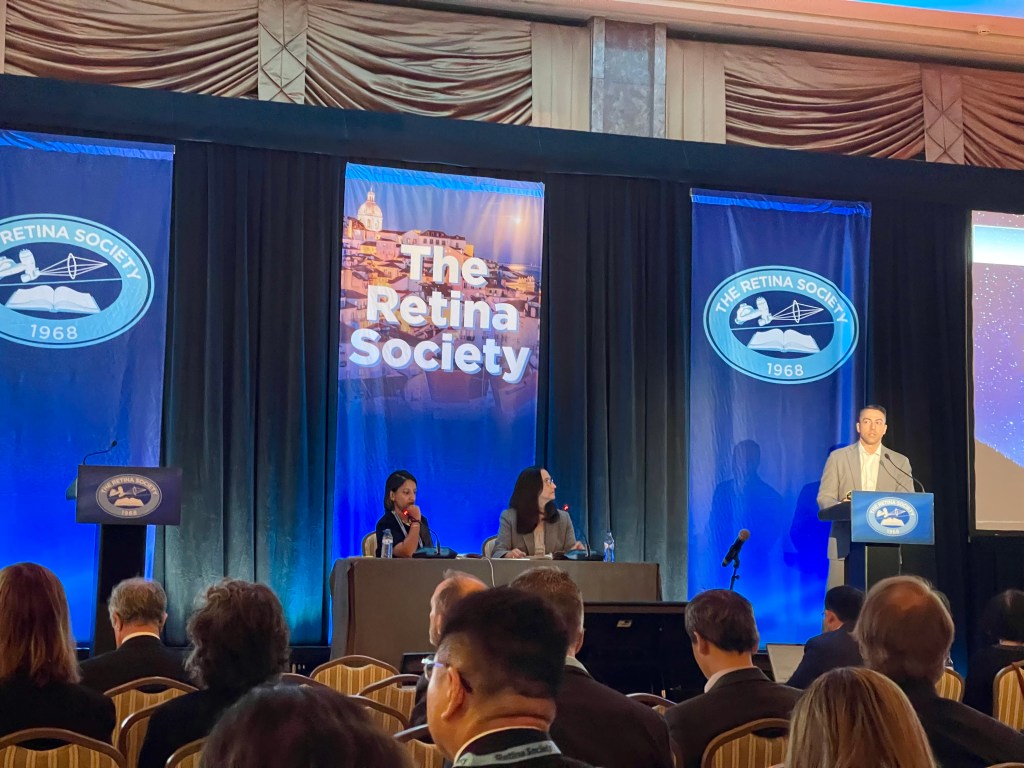Melissa Yuan, MD
Mass Eye and Ear, Boston MA

The fifth AMD session was moderated by Drs. Ferhina Ali and Deeba Husain. This action-packed session covered many aspects of AMD, from its genetic underpinnings and pathogenesis to potential new treatments and established therapeutic agents.
![]()
Dr. David Brown opened with his talk, entitled “Next Generation Anti-VEGF Agents — Is Twelve Weeks the New Norm?” quipping that “spoiler alert – not for everyone”. He discussed that various factors determine drug clearance including axial length, vitreous syneresis and anti-drug antibodies, and that aqueous and plasma concentrations of anti-VEGF agents can vary significantly among patients. Since drug injection frequency is directly correlated to drug clearance and the presence of anti-drug antibodies, he concluded that while the longer dosing interval may be possible with longer drug clearance time, some patients may require more frequent dosing even with next-generation agents.
The session then shifted to a focus on faricimab.
![]()
Dr. Ferhina Ali discussed “Imaging Biomarkers Supporting the Role of Ang-2 in Dual Inhibition With Faricimab for the Treatment of nAMD and DME.” Here, Dr. Ali and colleagues evaluated faricimab, a dual Ang-2/VEGF-A inhibitor, against aflibercept in patients with neovascular age-related macular degeneration (nAMD) and diabetic macular edema (DME). Imaging biomarkers from the TENAYA, LUCERNE, YOSEMITE, and RHINE trials were assessed. Results demonstrated faricimab’s superior reductions in central subfield thickness (CST) and fluid resolution compared to aflibercept, noting that pigment epithelial detachments (PED) were also reduced in size with faricimab. Dr. Philip Ferrone echoed these findings and discussed a post-hoc analyses of TENAYA and LUCERNE exploring the effect of faricimab compared to aflibercept on eyes with large serous PEDs in neovascular AMD. Faricimab-treated patients had a faster reduction in PED thickness compared to aflibercept, with a smaller proportion of eyes exhibiting persistent serous PED by week 12 and 48.
Dr. Ashkan Abbey reported newly released 2.5-year data from the TRUCKEE study in his talk, “Real-World Efficacy and Safety of Faricimab in Neovascular Age-Related Macular Degeneration: Two Year Results of the TRUCKEE Study.” This real-world multi-center study showed that treatment-naïve patients as well as patients switched from other agents experienced improvements in all anatomic parameters (SRF/IRF, CST), with some modest improvements in vision. The safety profile was excellent.
Dr. John Pitcher shared secondary analyses from TENAYA and LUCERNE Trials and found that rapid fluid resolution through week 12 with Faricimab is associated with both short and long-term extended durability, as patients with a rapid resolution of IRF/SRF were more likely to be on q16w vs q8w dosing both immediately after the loading dose period as well as at week 12. Also discussing TENAYA and LUCERNE Trials, Dr. Colin Tan focused on the potential for Q20W dosing. Results indicated that faricimab maintained better BCVA gains and CST reduction over two years compared to aflibercept, with more than half of faricimab-treated patients potentially eligible for Q20W extension.
Dr. Mark Johnson told a cautionary tale of a patient who had anterior uveitis after faricimab, and then subsequently had bilateral occlusive vasculitis after bilateral faricimab injections.
Switching topics, Dr. Itay Chowers then discussed genetic variants associated with AMD. In this study, weighted genetic risk scores were correlated with phenotypic features such as drusen, cRORA, subretinal drusenoid deposits, and hyperreflective foci. He showed that particular genetic pathways were associated with specific disease features; this may demonstrate, for example, that the complement cascade may affect cRORA and lipid metabolism may moderate the risk of developing drusen. Dr. Rick Spaide pointed out that we may be grouping together distinct diseases under an umbrella of AMD.
![]()
Flipping from nature to nurture, Dr. Deeba Husain discussed exogenous metabolomics and AMD. While AMD metabolomics have focused on endogenous metabolites, exogenous metabolites derived from environment, lifestyle and diet certainly play a role. Dr. Husain found 4 metabolites associated with presence of AMD and 10 associated with AMD stage. Antioxidants (such as thioproline, found in fish, nuts, and mushrooms) were protective, while tartronate, a plant-based metabolite of potatoes, conferred risk for AMD. Dr. Demetrios Vavvas later gave a review of proteomics in AMD and highlighted that the finding of several distinct pathways suggests that AMD is likely a group of heterogeneous diseases.
![]()
Dr. Dimitra Skontra then described a case control study looked at whether patients with GA had exposure to metformin in the one year prior to diagnosis. This found that metformin reduced the odds of GA by 47% in patients without diabetes. Dr. Jeremy Lavine showed through propensity score matching in a large database that levodopa, a medication for Parkinson’s disease, was noted to reduce the incidence of GA by 32%.
![]()
Dr. Rufino Silva showed that the risk of developing AMD was associated with baseline stage, age, genetic risk variants (CFH, ARMS2/HTRA1) and nutrition using a variance influence analysis model. For example, he showed a patient in which smoking increased the risk score from 50% to 90%, while exercise decreased the risk to 3%. Dr. Johanna Seddon then discussed the extent to which healthy lifestyle behaviors could offset high genetic risk for progression to advanced AMD after controlling for baseline demographics. She showed that the risk of progressing to advanced AMD in patients with a high genetic load can be reduced by lifestyle modifications (in particular smoking).